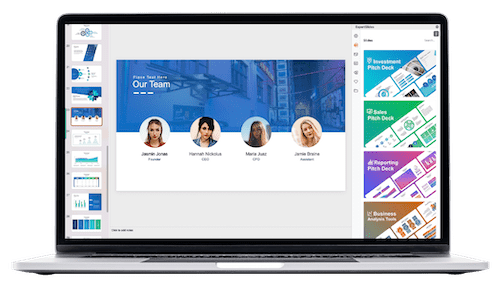Logic Model Template Powerpoint: Everything You Need to Know
Table of Contents
A logic model they is a visual demonstrate of those relationships between program parts and results. It an important tool for program planning executing and assessing. Logic models gives a shared understanding for how the program work and it’s expected result which make easier to talk with stakeholder.
In this PowerPoint template guide we talks about all the stuffs you gotta know to make a logic model with PowerPoint. We goes over the main parts of a logic model, how you can build it one step after another and some advices for using it good when you’re planning and checking on programs. No matter if your new at logic models or just want to get better at yours, this handbook is super useful for peoples working on making and managing programs.
What is a Logic Model?
A logic model be a picture that show the way a program function by showing how all it parts fits together and what it aims to achieve. It act like a guide for making plan putting into action and checking out programs. Logic models is used a lot in different areas like in schools public health people helping services and making communities better.
A logic model fundamentally rests on the theory of change that maps out supposed cause-and-effect links between inputs activities outputs and results. Inputs is about what resources be put into the program like money people hours and supplies. The things the program does to get what they want is called activities. Outputs is whatever comes straight from them things like number of workshops or how many people gets help. Results are the good stuffs that happens because of what the program did, like better understanding or how folk acts different now.
Logic model help to make clear the reasoning behind program and what it suppose to achieve. It also provide framework for measure and evaluate how well the program does. By identify input, activity, output and outcome stakeholder can understand how each part contribute toward meeting overall goal of the program.
Where to Use Logic Models
Logical models get used at different steps in program making and handling like when you start planning up to when evaluating things. While planning, these models assist folks partaking in the program figure out and give voice to what they wanna achieve and what stuff is necessary for it to go well. It also aids them lay out a straight plan showing one thing that leads to another and the results they hope for.
During implementation logic model acts like a guide for program staffs to ensure their activities is aligned with they’re intended outcomes, it also help identifying any gap or areas for improvements in programs design.
Logic models is valuable tool for program checking how well they doing. When you match real results with what we’re supposed to expect from logic model evaluators can see if the program reach their goals and find places where it can get better. This kind of models also helps in figuring out the right data for collection and measure steps forward toward them results.
Additionally logic model can be utilize for speak with stakeholder like funder and community member. It provides clear understand of program objective activity and expect outcome help make easier to gather support and engaging stakeholders in they program.
How to Create a Logic Model Using PowerPoint

Build a logic model with PowerPoint be easy and it work good for see how program do its thing. Here some step to take:
Start with a clear understanding
In making a logic model he must be familiar with what the program aim for and it goals. This mean knowing who the program meant to help, what results they want and which resources is there for use in programs.
Stakeholder involve is also essential for develop robust logic models. Involving key stakeholder like program staffs participants community member and funder can provides valuable insight and ensures comprehensive understand of programs.
Once purpose and goals is set up then we begins to make the logic model. You can utilizes different tools like flowchart diagram or table for this. PowerPoint are a great tool to create logic models because it have easy-to-use interface and visual designs option.
Furthermore using template can makes process even more easier and efficient. This PowerPoint logic model templates provide a simple layout with pre-designed shape and text box, making its easy to customize for you specific program.
Identify the Inputs, Activities, Outputs
Next thing you do is to pinpoint main parts of your program and the way they connects. This involve finding out what the inputs activities outputs and outcomes are.
Resources that gets putted into the program is what input means. It might include money, time from staffs equipments or stuffs.
Program do specific stuffs like doing workshops trainings and reaching out people in the community or give direct help for meet their goals. They does this things to get what they want done.
The results is immediate product from these actions. It could be measure by amounts like how many peoples was help or teach.
Outcomes is the change or benefit that comes from the program outputs. They can range from short term outcomes like more knowledge or skill to long term outcomes like better health or community changes.
Open PowerPoint and Create a Blank Slide
Go ahead and start up PowerPoint to make an empty slide. You do this by clicking “New” on the File menu then you pick “Blank Presentation.”
After you has got a empty slide him should split it into four parts for the input activities outputs and outcome. This be done by putting in two line horizontal and two line vertical to make a grid with four same size section.
Add the Title and Program Name
You last should to put a title and program name on you’s logic model. It supposed be at the top middle of slide very clear showing what this logic model are for.
After that you can throw in text boxes inside every single quadrant for filling your inputs activities outputs and its outcomes. You make sure to use language that’s clear and direct which properly show what your program is about.
You might as well put in visuals like symbols or pictures for make your logic model look better and simpler for grasp.
Make sure to always look over and adjust you logic model when it’s needed this go extra true if you’re making changes or checking how the program works. If you makes a good logic model it can be really helpful for plan programs manage them evaluate things and talk about it with people who has interest in your work.
Keep them steps ready and get started on making your logic model in PowerPoint it will make your program development and management way better. By following them simple steps making a logic model with PowerPoint can turn into a great way to hit the goals for the program. It give you a picture of what’s going on with the program logic so everyone gets it more clear and can talk about it with people involved.
Can any program use a Logic Model?
Sure any programs can benefit from using logic models, no matter if it’s for social services education or even business efforts a logic model help in the planning managing and evaluating of these program.
To make a good logic model, you need to really get what the program aim for. You gots to know who it’s supposed to help, what it’s hoping to achieve and what stuffs are there to work with.
A logic model being in place can helps program to stay on track and make decisions based on data by mapping out inputs activities outputs and outcomes it get easier for identify any gaps or improvement areas.
Logic model not just help in checking programs they also good for when you plan and make the program. When stakeholder work together on making a logic model it helps so that everyone understand and work to the same aims of program.
Furthermore logic model can also be use for talk with funders and other stakeholder. A good-built logic model can show off the program potential impacts and how resource is being used.
Should the Logic Model be a Static Document?

No, the logic model should not be viewed as a static document. It is an ever-evolving tool that should be regularly reviewed and revised as needed.
As programs change and evolve over time, so do their inputs, activities, outputs, and outcomes. Therefore, it is crucial to update the logic model to reflect any changes in the program’s design or implementation.
Regularly reviewing and updating the logic model can also help identify any gaps or areas for improvement. It allows programs to track their progress, make data-driven decisions, and adjust strategies as needed.
Moreover, involving stakeholders in the review and revision process can ensure that everyone is on the same page and working towards the same goals. It can also help generate new ideas and perspectives, leading to a more comprehensive and effective logic model.
In addition, having an updated logic model can make it easier to communicate with funders and other stakeholders. A dynamic logic model that reflects the program’s progress and impact can showcase its effectiveness and potential for success.
It is also important to note that the logic model may need to be adapted for different audiences. For example, a simplified version may be more suitable for communicating with community members, while a more detailed and complex version may be necessary for funders or program evaluators.
Where to not Use a Logic Model
While logic models can be beneficial for most programs, there may be some instances where it may not be necessary or appropriate to use one.
For example, if the program is short-term and has very simple inputs, activities, and outcomes, creating a logic model may not add much value. In this case, a simpler planning tool, such as a timeline or action plan, may suffice.
Additionally, if the program has highly complex and unpredictable outcomes, a logic model may not accurately capture all the potential factors that could influence the outcomes. In this case, alternative evaluation methods such as qualitative research or case studies may be more suitable.
Furthermore, if the resources and/or time constraints do not allow for an in-depth logic model, it may be more practical to use a simpler planning tool or rely on existing data sources.
Another instance where a logic model may not be suitable is if the program operates in an ever-changing environment. In this case, a dynamic and regularly reviewed logic model may be challenging to maintain and may not accurately reflect the program’s reality.
Lastly, if there are no clear goals or objectives for the program, creating a logic model may be difficult and unproductive. In this case, it may be necessary to first establish the program’s purpose and desired outcomes before attempting to create a logic model.
Tips for Creating a Logic Model
Involve stakeholders: When creating a logic model, it is important to involve all relevant stakeholders. This includes program staff, community members, funders, and other partners. By involving these individuals, you can ensure that everyone’s perspectives and contributions are incorporated into the logic model.
Clearly define the program’s purpose and goals: Before starting the logic model, it is crucial to have a clear understanding of the program’s overall purpose and desired outcomes. This will serve as the foundation for all other components of the logic model.
Use simple and clear language: The logic model should be easy to understand for all stakeholders, regardless of their background or level of expertise. Therefore, it is important to use simple and concise language when describing inputs, activities, outputs, and outcomes.
Map out each component in detail: Each component of the logic model (inputs, activities, outputs, and outcomes) should be thoroughly mapped out with specific details. This includes the resources needed for inputs, a step-by-step description of activities, and clear measures for outputs and outcomes.
Be realistic: It is important to be realistic when creating a logic model. This means accurately representing the program’s resources, activities, and outcomes. Unrealistic expectations or overestimating outcomes can lead to ineffective planning and evaluation.
Regularly review and update: As mentioned earlier, the logic model should not be viewed as a static document. It is crucial to regularly review and update it as needed to accurately reflect the program’s progress and impact.
Tailor the logic model to fit the program: Each program is unique, and therefore, the logic model should be tailored to fit its specific goals and outcomes. Avoid using a one-size-fits-all approach.
By following these tips, programs can create a comprehensive and effective logic model that can serve as a valuable planning and evaluation tool.
FAQs
What are logic model templates for PowerPoint and why are they useful?
Logic model templates for PowerPoint are pre-designed frameworks that help users map out the logical sequence of their project or program, from inputs to outcomes. These templates serve as a great tool for planning, implementing, and evaluating projects by visually representing the essential information in a structured manner. They’re particularly useful for ensuring all team members understand the project’s goals, strategies, and expected impacts.
How can a logic model template improve my project presentation?
A logic model template can significantly improve your project presentation by providing a clear and concise overview of your project’s framework. It helps you present the inputs, activities, outputs, outcomes, and impacts of your project in a logical sequence, making it easier for your audience to grasp the relationships between different components of your project. This clarity can enhance stakeholder understanding and support.
Are logic model templates customizable for different types of projects?
Yes, logic model templates are designed to be fully customizable to suit various types of projects and programs. You can modify elements such as text, color, and layout to fit the specific needs of your project, including adjusting the categories of inputs, activities, outputs, and outcomes. This flexibility allows you to tailor the template to precisely convey the essential information of your project.
Can I use logic model templates for both small and large projects?
Absolutely! Logic model templates are versatile tools that can be used for projects of any size, from small initiatives to large-scale programs. They help you organize and present the key components of your project, regardless of its complexity. By laying out the inputs and logical sequence of activities, these templates can be an invaluable resource for clearly communicating the scope and objectives of your project to stakeholders.
Conclusion
To wraps it up logic models is a good stuff for plan and check on programs but you shouldn’t see them as something that don’t change they needs to be looked at again and changed when you gots to. Even if it ain’t fit for all the things or times listening to some advice will make sure the logic model show right what the program’s trying to get done and what it actually does.
Involving peoples who have an interest, making sure the purpose and goal is clear using easy words laying out each part being practical and fitting it to the program make a logic model that guides planning and making choices good. It’s important for them programs to always look over and refresh their logic models so they keeps on track and uses data to make decisions that ends up in success.
Related Blogs
Get 7+ Mio. PowerPoint Assets - FREE SIGN-UP

Sign up for free to our PowerPoint extension, ExpertSlides. Everything you need, directly in PowerPoint. No credit card required.
Related Posts
